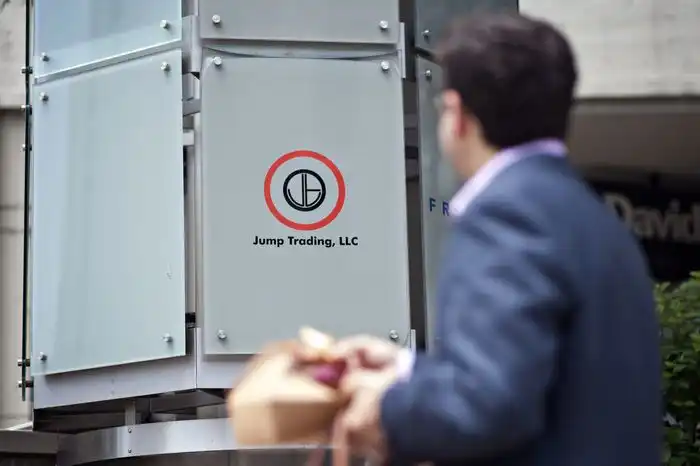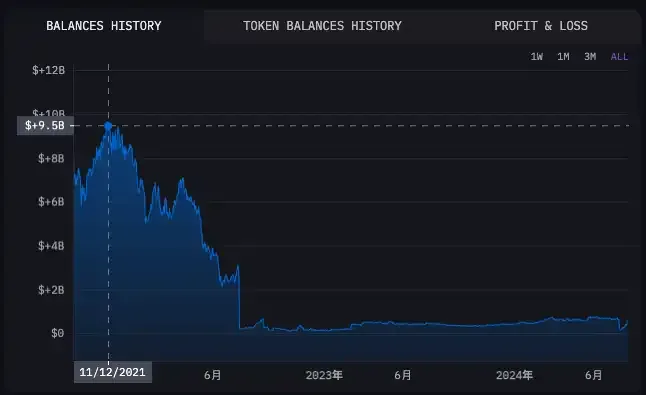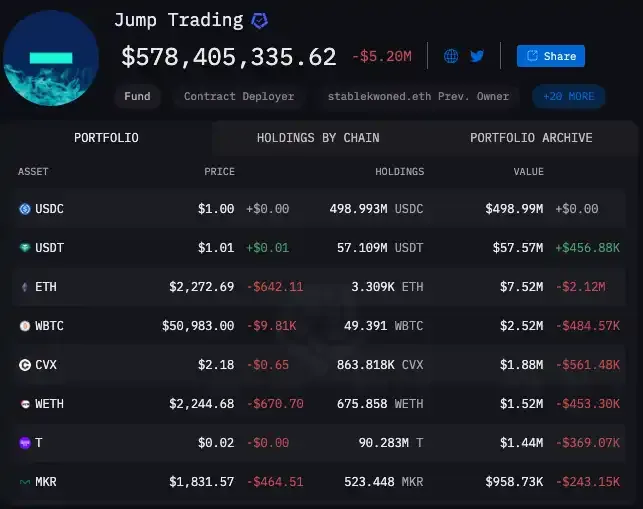The Culprit Behind the Crypto Crash Revealed: Top Market Maker Jump Under Fire?
This is a day that will go down in history in 2024. Global financial markets collapsed across the board, with NVIDIA plummeting 14% in overnight trading and stock markets in Japan and South Korea experiencing historic downturns.
The crypto market was no exception, with Bitcoin briefly falling below $50,000 and Ethereum plummeting over 25%, erasing all gains for the year. The market was in disarray, with DeFi platform liquidations soaring to $320 million, setting an annual record.
This situation brings to mind the devastating crypto crash of “312“. As market participants speculated on the cause of this crash, aside from the conclusion of Japan’s 20 trillion arbitrage, many in the crypto community focused their attention on the top market maker, Jump Trading.

Jump Nearly Emptied Its Holdings
Arthur Hayes, co-founder of BitMEX and an early crypto kingpin, posted on social media that he had learned through traditional finance channels that a “major player” was liquidating crypto assets. Hayes stated he didn’t know if it was true, “I won’t name names, but if you’ve heard the same, let people know.”

Though he didn’t specify names, community speculation quickly pointed to Jump Trading and its crypto division, Jump Crypto. Some users even mocked Jump by renaming it “Dump” to suggest a massive sell-off, with some directly posting pictures of former Jump Crypto CEO Kanav Kariya.

These suspicions were not unfounded. On-chain data analysis revealed some clues. According to EmberCN, Jump Trading had been gradually redeeming its $410 million worth of wstETH, converting it to ETH and transferring it to Binance and OKX.
Since July 25, Jump Trading had redeemed 83,000 wstETH, exchanging it for 97,500 ETH, of which 66,000 ETH (approximately $191 million) had been moved to exchanges.
At the time of writing, Jump Trading still held 37,600 wstETH and 11,500 STETH, both in the process of being unstaked on Lido Finance.

According to Arkham, at the peak at the end of 2021, Jump’s address held nearly $10 billion, but now this same address has less than $600 million in assets.
Furthermore, this $595 million position has significantly shifted towards stablecoins, with USDC and USDT holdings comprising 96%.
These include: USDC holdings worth US$468 million; USDT holdings worth US$103 million; ETH holdings worth US$8.7 million; WBTC holdings worth US$2.68 million; CVX holdings worth US$1.95 million; and WETH holdings worth US$1.56 million.

The Mysterious King of High-Frequency Trading
When talking about the most powerful high-frequency trading companies, the name Jump Trading cannot be avoided.
Jump Trading, founded in 1999 and headquartered in Chicago, is renowned for its high-frequency trading and complex algorithmic trading strategies, holding significant influence in global financial markets. The company primarily engages in traditional financial market activities, including stocks, futures, and forex.
Founders Bill DiSomma and Paul Gurinas, both former CME floor traders, foresaw the dominance of computers in arbitrage trading as financial markets began transitioning to electronic trading in the early 1990s. This led them to establish Akamai Trading LLC in 1999, which was rebranded as Jump Trading in 2001.
Jump Trading, a titan in the high-frequency trading world, invests heavily in technology to maintain its trading speed advantage. From fiber optics to microwave towers, undersea cables, and even satellite links, Jump constantly explores and adopts cutting-edge technology to optimize trading speed. They further enhance their high-performance computing and AI-driven trading systems by collaborating with top tech companies.
Notably, since its inception, Jump has operated with great secrecy, quietly amassing wealth and earning the title of the world’s most mysterious high-frequency trading giant. As a privately held company using only its own funds for trading, little is known about its internal operations or financial status.
Jump maintains strict confidentiality, with company officials rarely granting interviews, and former employees remaining tight-lipped about the company.
From $80 to $8, Jump Still Bullish on Solana
In 2021, Jump Trading’s typically secretive approach began to shift, with its venture capital partners becoming more publicly engaged through podcasts, blogs, and videos sharing their insights and experiences.
Jump Trading launched a retail brokerage division in 2021, offering execution services for individual investors’ stock and crypto trades. This partnership with Robinhood solidified its position in the online brokerage space. According to SEC filings, Jump paid Robinhood the equivalent of 17% of the brokerage’s total revenue in the first three quarters of 2021, about $247 million, enhancing its influence in the retail market.
“Clearly, Jump has always been a fairly quiet company, but as the market and our business have evolved, we will become more public-facing,” said David Olsen, President and CIO of Jump Trading.
In 2022, Jump Crypto was established, led by 26-year-old Kanav Kariya from India, a former Jump intern.

Jump Crypto invested 40% of its seventh fund (totaling $350 million) into the crypto space, focusing on DeFi, Web 3.0, blockchain, and financial applications.
Since its inception, Jump Crypto has played a significant role in market making and blockchain project investments, particularly within the Solana ecosystem.
One of Jump Crypto’s key contributions to Solana was developing a new validator client called Firedancer. This project aimed to enhance Solana’s blockchain throughput and network stability, addressing previous issues of frequent network outages and speed reductions, significantly improving Solana’s infrastructure and overall reliability.
Jump Crypto also played a crucial role in Solana’s decentralized growth by solving technical problems and investing substantial funds and resources, helping Solana become one of the world’s most popular blockchains with applications in finance, NFTs, gaming, and more.
Even when Solana plummeted from $80 to below $8 within a week in 2022, Jump Trading’s David Olsen publicly remained bullish on Solana. It’s fair to say Jump has been a key driver of the Solana ecosystem.
Besides Solana, Jump also invested in Wormhole, Lido, AltLayer, Celestia, Aptos, Injective, and other major crypto projects, each one a leading name in the crypto world.
Legal Troubles and CEO Departure, Jump Goes Quiet Again
However, Jump Crypto has faced significant challenges. Under Kanav Kariya’s leadership, it was a tumultuous period.
In early 2022, Jump-supported Wormhole’s crypto bridge was hacked, resulting in losses exceeding $300 million, which Jump covered out of pocket.
Jump Crypto’s trading and investment activities attracted significant attention from U.S. regulators. In June, Fortune reported that the CFTC had launched an investigation into Jump Crypto. Although the specific reasons for the investigation were not disclosed, it was seen as part of broader regulatory scrutiny of the crypto industry. This investigation pressured Jump Crypto to scale back some operations in the U.S.
Jump Crypto was also embroiled in several controversies. The collapse of FTX caused significant financial losses for Jump Crypto. Additionally, its role in the TerraUSD collapse drew regulatory scrutiny, with U.S. officials noting that Jump profited over $1 billion from the Terra/Luna ecosystem before its collapse.
A few days after news of the CFTC investigation, Kanav Kariya announced his departure as CEO of Jump Crypto, expressing mixed emotions and future aspirations on Twitter.

Reflecting on June 2022, when the crypto market was highly volatile, especially with the TerraUSD and Luna collapse causing widespread panic and significant market declines, Bloomberg reported that Kariya confidently stated in a company meeting, “Jump Crypto is not exposed to risk, is not in a liquidity crisis, and is still hiring.”
However, Kariya’s departure now seems to mark a significant turning point for Jump Crypto amid sudden asset sales and widespread external speculation. Jump Crypto chose silence and did not publicly respond.

Notably, except for Jump Capital’s Twitter and LinkedIn updates, Jump Trading, Jump Crypto, and Jump Crypto Engineering’s social media accounts have not been updated since September 2021, September 2023, and May 2023, respectively.
It seems that history is repeating itself, and Jump, which had gradually become more open, has returned to its mysterious state from three years ago, becoming “quiet and hidden” once again.